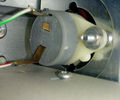Potentiometers: Difference between revisions
No edit summary |
No edit summary |
||
| Line 2: | Line 2: | ||
Often, just working the potentiometer back and forth over its range is sufficient to rejuvenate it. | Often, just working the potentiometer back and forth over its range is sufficient to rejuvenate it. | ||
Other times, it is necessary to spray some cleaner into the pot. | Other times, it is necessary to spray some cleaner into the pot. | ||
Many of the potentiometers in Tektronix instruments are parts Tek bought. | |||
Some of the potentiometers were made by Tek. | |||
In 1962, Tek-made potentiometers started being used in many instruments. | |||
These are typically identifiable by their gray delrin cover (and their Tek part number). | |||
They are "stopless" pots, which means that they have a detent but can be rotated through the detent. | |||
This feature was intended to reduce shaft and pot problems that result from excessive torque on traditional pots. | |||
<gallery> | <gallery> | ||
Latest revision as of 10:03, 14 October 2018
Potentiometers are a common source of problems in old scopes. Often, just working the potentiometer back and forth over its range is sufficient to rejuvenate it. Other times, it is necessary to spray some cleaner into the pot.
Many of the potentiometers in Tektronix instruments are parts Tek bought. Some of the potentiometers were made by Tek. In 1962, Tek-made potentiometers started being used in many instruments. These are typically identifiable by their gray delrin cover (and their Tek part number). They are "stopless" pots, which means that they have a detent but can be rotated through the detent. This feature was intended to reduce shaft and pot problems that result from excessive torque on traditional pots.
-
Tek-made pot, part number 311-0304-00, VAR GAIN in a 3A74.
